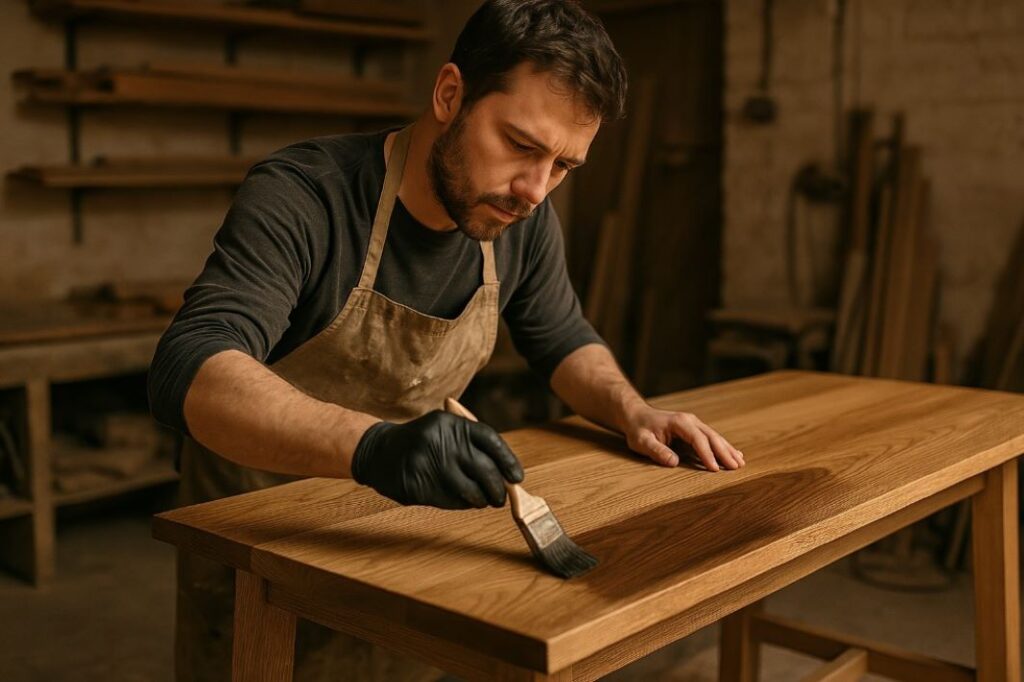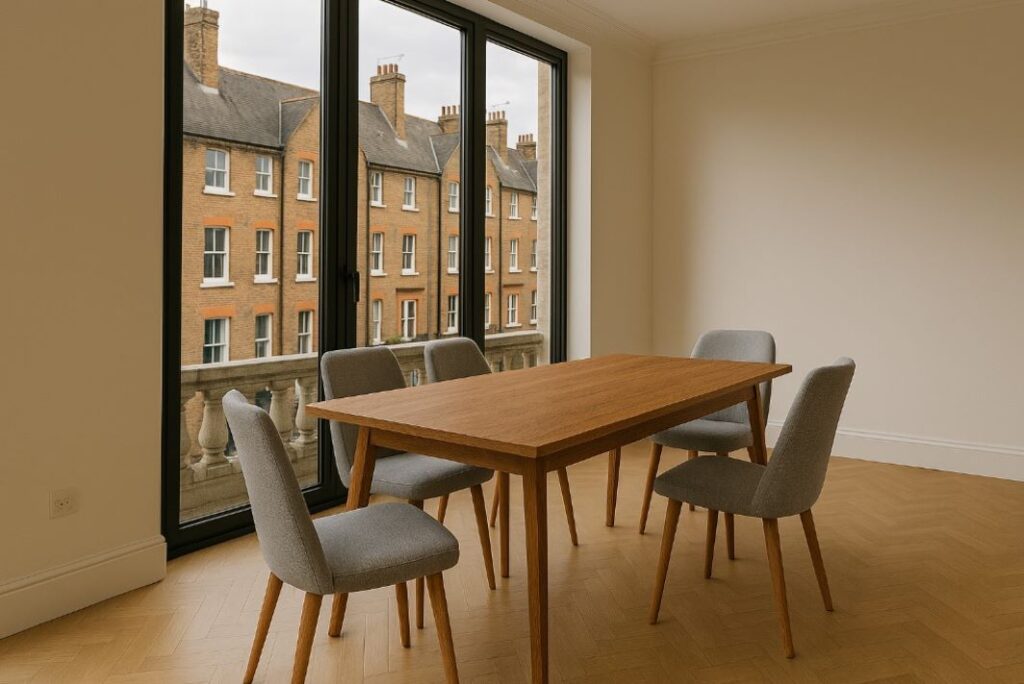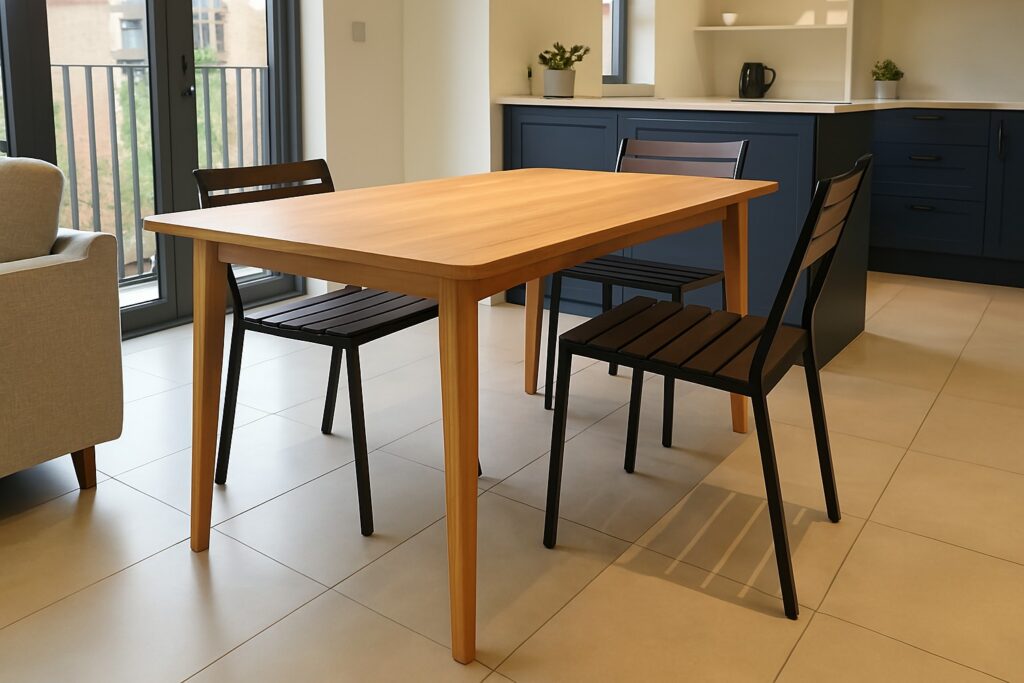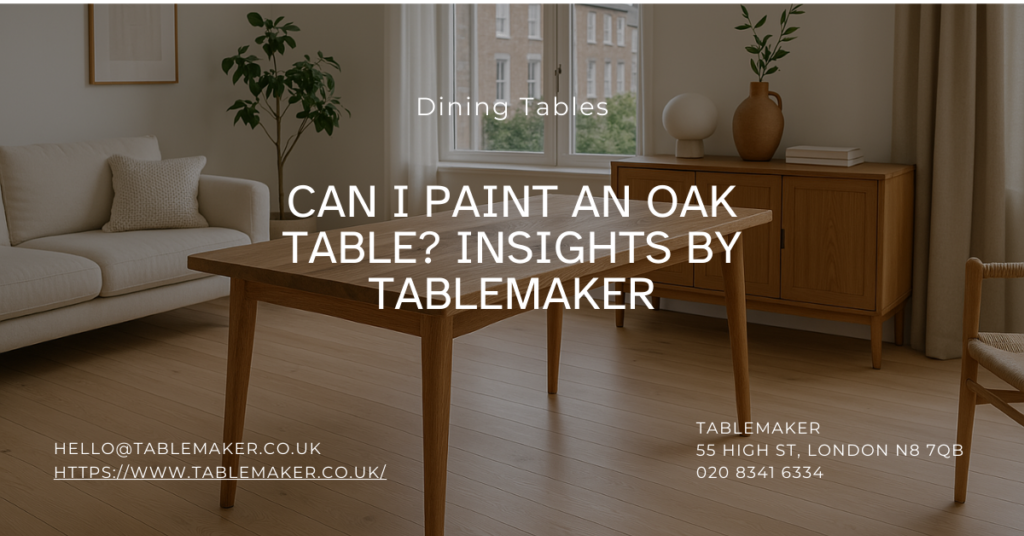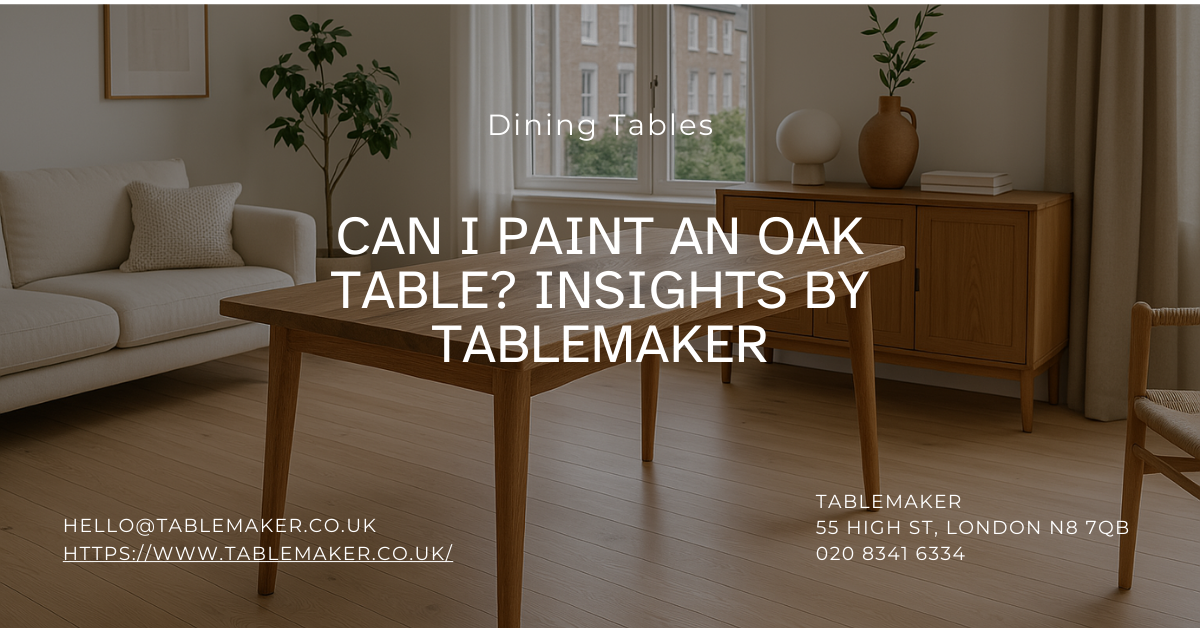
Can I Paint an Oak Table? Insights By Tablemaker
Can you paint an oak table without ruining it?
Yes, you can paint an oak table without damaging it, provided you follow the correct preparation and finishing steps. Painting oak can be a brilliant way to update tired or damaged furniture, making it more suitable for modern interiors or matching it to existing decor. The key to success is careful cleaning, sanding, priming, and choosing the right type of paint and brushes. Done properly, painting an oak table gives it a completely new look while retaining its strength and structure.
In this article about painting oak tables we have covered
- Can you paint an oak table without ruining it?
- Why paint oak furniture in the first place?
- Choosing the right oak table to paint
- How much time do you need to paint an oak table?
- What tools and materials will you need?
- Step 1: Clean the table thoroughly
- Step 2: Remove any removable parts
- Step 3: Sanding for a better surface
- Step 4: Should you use primer on oak?
- Step 5: Choosing the best paint for oak tables
- Step 6: Apply thin coats of paint
- Step 7: Drying and curing your painted table
- What if you want a distressed or shabby chic finish?
- How to maintain a painted oak table
- Common mistakes to avoid
- Final thoughts
- Did you know?
Why paint oak furniture in the first place?
Oak is a hardwood known for its durability and beautiful grain, which is why many people feel hesitant about painting over it. But paint is not about hiding its quality. Instead, it gives you a way to cover surface imperfections, change the colour scheme, or give the table a new function elsewhere in the home. Upcycling older oak furniture rather than buying new pieces also helps reduce waste and often saves money.
Painting can also refresh your space at a fraction of the cost of buying new. If your oak table has scratches, stains, or just does not fit your current style, a new coat of paint can make a big difference. It is also a chance to bring your table in line with other furnishings, particularly if you are working with made to measure furniture in specific tones.
Choosing the right oak table to paint
Not all oak furniture is equal. Solid oak tables are perfect candidates for painting, especially if they are scratched or discoloured. Avoid painting pieces that have high value as antiques or where the oak grain is too beautiful to cover. Veneered oak tables can also be painted, but extra care is needed to prevent lifting or bubbling. Look for stable construction and minimal water damage before starting.
If you are starting from scratch and want a table that is ideal for future customisation or repainting, Tablemaker offers a range of solid oak tables handmade in the UK. These tables are made from real hardwood with no chipboard or veneers, which means they can be refinished or painted multiple times.
How much time do you need to paint an oak table?
Painting an oak table is not something to squeeze into a free hour. It takes several days to do it well, with drying time between coats being the biggest factor. You will need time for preparation, priming, and at least two coats of paint. Rushing through any stage risks peeling, bubbling, or an uneven finish.
What tools and materials will you need?
You do not need professional gear, but having the right tools makes a big difference. Here is a list of the basics:
Sandpaper or sanding block (150 to 220 grit)
Cleaning solution (such as sugar soap or trisodium phosphate)
Lint-free cloths
Dust sheets to protect floors
Primer (especially for knotty or dark oak)
Suitable paint (latex or oil-based wood paint)
High quality paintbrushes or foam rollers
Masking tape
These items help you create a smooth, long-lasting finish with fewer problems down the line.
Pro Tip: Always sand oak back to bare wood before painting — old finishes like hardwax oil can stop paint from sticking properly.
Step 1: Clean the table thoroughly
Start by giving your oak table a deep clean. Remove any built-up grease or grime, especially if the table is used in the kitchen. A mix of warm water and sugar soap works well. If there is an old finish, a citrus-based stripper can help remove it. Allow the table to dry completely before moving to the next stage.
Step 2: Remove any removable parts
Take off drawers, handles, and legs if possible. This gives you better access to corners and stops you from accidentally painting over moving parts or metal fittings. Use masking tape to label parts so you know where they go later.
Step 3: Sanding for a better surface
Sanding is the most important part of getting your paint to stick. Use a medium grit sandpaper to roughen up the surface and remove gloss or old varnish. For a really smooth finish, finish with a fine grit. Always sand along the grain of the wood. After sanding, vacuum the dust and wipe everything with a damp cloth.
Step 4: Should you use primer on oak?
Yes, especially if the oak has visible knots or a dark finish. Primer helps paint stick and stops the natural tannins in oak from bleeding through the top coat. Use a wood-specific primer and let it dry fully before applying your first coat of paint. Some high-quality paints are self-priming, but using a dedicated primer still gives better results.
Step 5: Choosing the best paint for oak tables
The type of paint matters. For tables that get regular use, latex or acrylic latex paint is a strong choice because it dries fast and is easy to clean. Oil-based paints offer a tougher finish but take longer to cure. Satin and eggshell finishes are popular because they are easier to clean than matte and less shiny than gloss. Always check the label to make sure the paint is suitable for wood surfaces.
Step 6: Apply thin coats of paint
Apply your first coat using smooth, even strokes that follow the grain. Do not overload your brush or roller. Thin layers give a more professional finish and reduce brush marks. Wait for the coat to dry completely before applying the next. Most projects need two to three coats for solid coverage.
Step 7: Drying and curing your painted table
Leave the table to dry for at least 24 hours before light use. For full curing, which gives the paint its full hardness and resistance, leave it untouched for up to seven days. Avoid placing heavy items or wiping it down during this period.
Pro Tip: Use a stain-blocking primer designed for hardwoods — it prevents tannins in oak from bleeding through lighter paint colours.
Talk to our London Table Specialist
At Tablemaker, we’ve been helping locals in London find the best oak table for years — tailored to your space, your style, and your everyday life.
What if you want a distressed or shabby chic finish?
Distressing is a popular technique if you like a vintage or rustic look. After painting, lightly sand edges and corners where natural wear would occur. You can also try dry brushing a second colour over the top to create a layered effect. Always seal distressed finishes with a furniture wax or clear coat to prevent flaking.
How to maintain a painted oak table
Clean the surface with a damp cloth and avoid harsh cleaners. If you notice chips or scratches, lightly sand the affected area and touch it up with leftover paint. Adding felt pads to the legs and avoiding dragging items across the top can help preserve the finish for longer.
Common mistakes to avoid
Skipping sanding or cleaning
Using the wrong type of paint
Not waiting for each layer to dry fully
Painting in a dusty or damp environment
Ignoring manufacturer’s drying times
Can you return a painted oak table to its original look?
Technically yes, but it involves a lot of sanding and possibly using paint stripper. The process is time-consuming and may not restore the original grain perfectly, especially if a dark primer or several paint coats were used. Think carefully before painting valuable or sentimental pieces.
Final thoughts by Tablemaker
Painting an oak table is a satisfying and cost-saving way to refresh your furniture. With the right tools, a bit of time, and some patience, your old table can look new again and fit perfectly into your home. If you are considering painting oak furniture throughout your home, this same method applies to sideboards, cabinets, or even oak doors.
Looking for oak furniture to upcycle? Visit Tablemaker for beautifully built, solid oak furniture that is ideal for custom finishes. Every piece is handmade in North London using real wood that can be sanded, painted, and reused for years.
Did you know?
Over 70% of UK households engage in DIY projects at least once a year, with furniture upcycling like painting oak tables being among the most popular. This trend is supported by the growing interest in sustainability and cost-saving methods, particularly as consumers look to reduce waste and personalise their interiors.
Get Friendly Advice on Painting Your Oak Table from a North London Furniture Maker
Thinking about painting your oak table but not sure where to start? We’ve seen it all — patchy finishes, peeling paint, the wrong products — and we’re here to help you avoid the common mistakes.
At Tablemaker in North London, we’ve worked on everything from refinishing worn-out tops to fully repainting custom oak dining tables. Whether you’re tackling it yourself or weighing up your options, we’ll give you honest, practical advice based on real experience.
Pop in, call us, or send a quick email — no hard sell, just straightforward guidance.
Here’s how to get in touch:
Visit us: 55 High St, London N8 7QB
Call: 020 8341 6334
Email: [email protected]
Website: www.tablemaker.co.uk
Opening hours:
Monday–Wednesday: 9 am–3 pm
Thursday–Friday: 9 am–4 pm
Saturday & Sunday: Closed
We’re based right here in Hornsey — drop by for advice that’s as solid as the tables we make.
Tablemaker
55 High St, London N8 7QB
02083416334
HVQM+58 London

